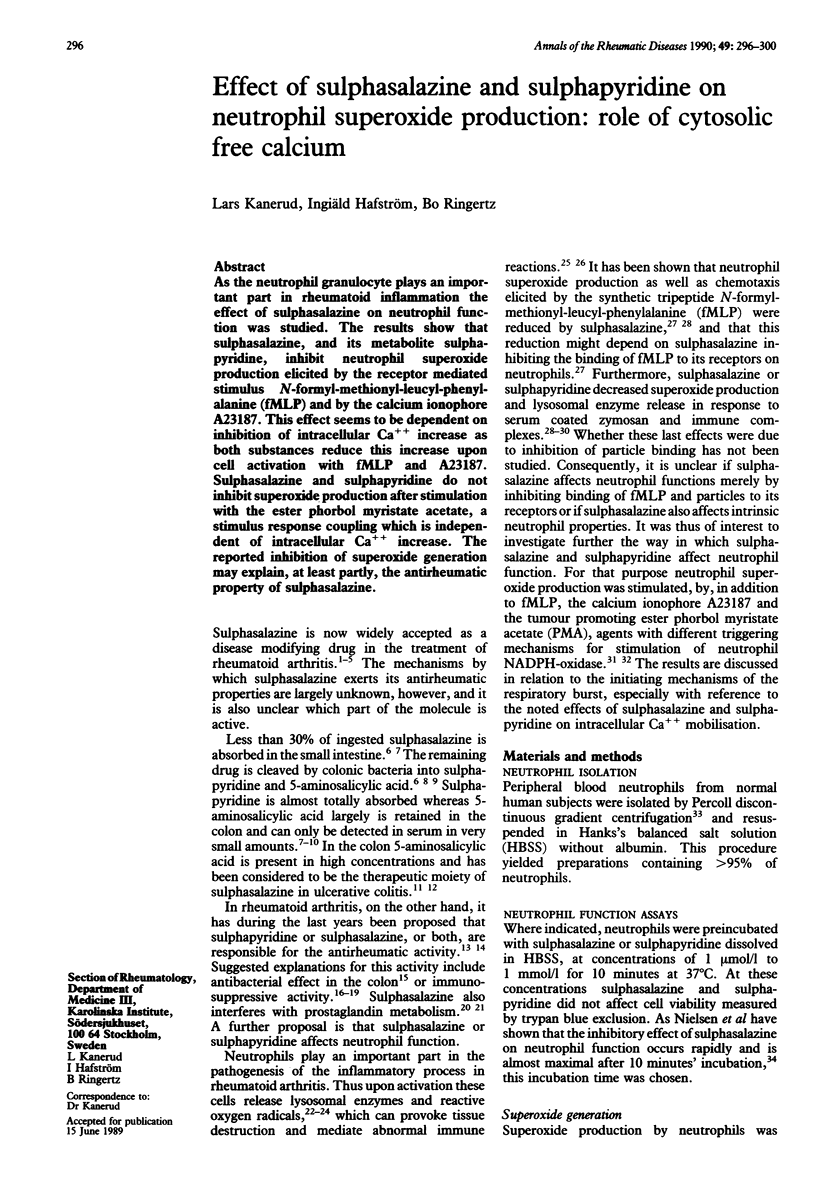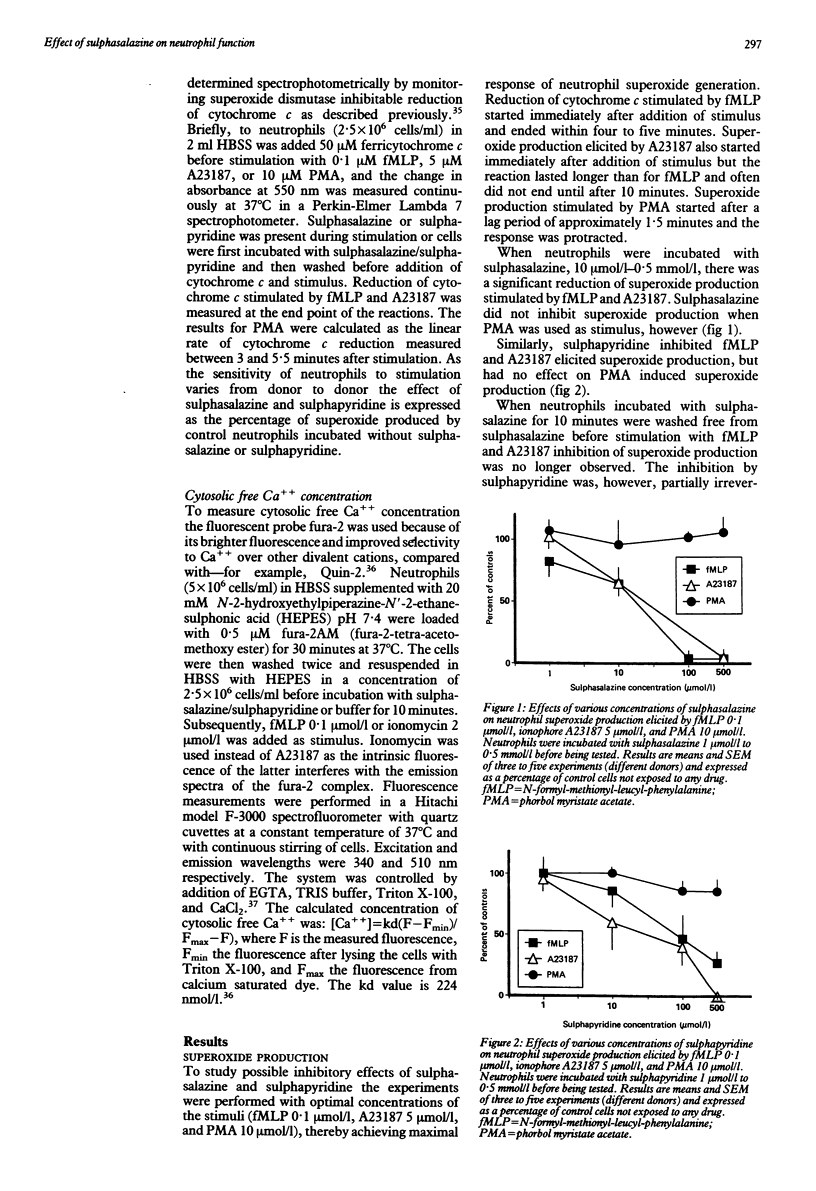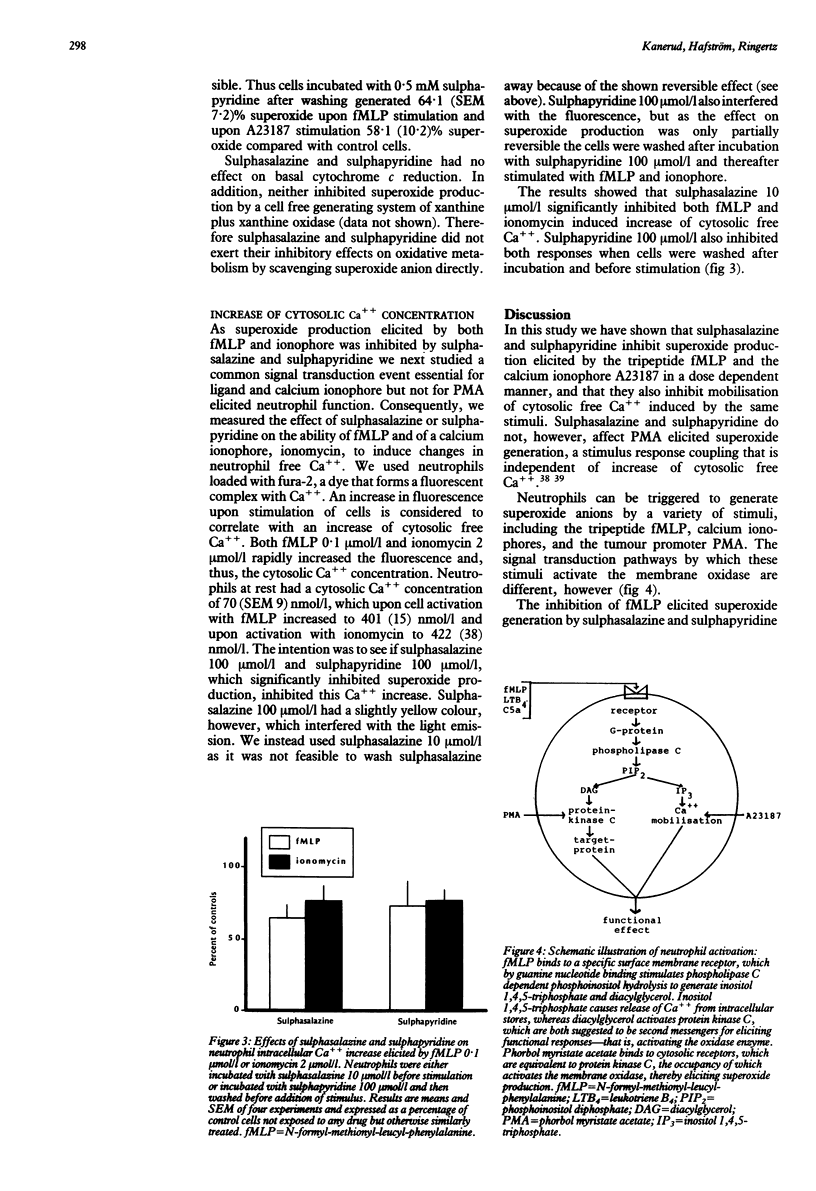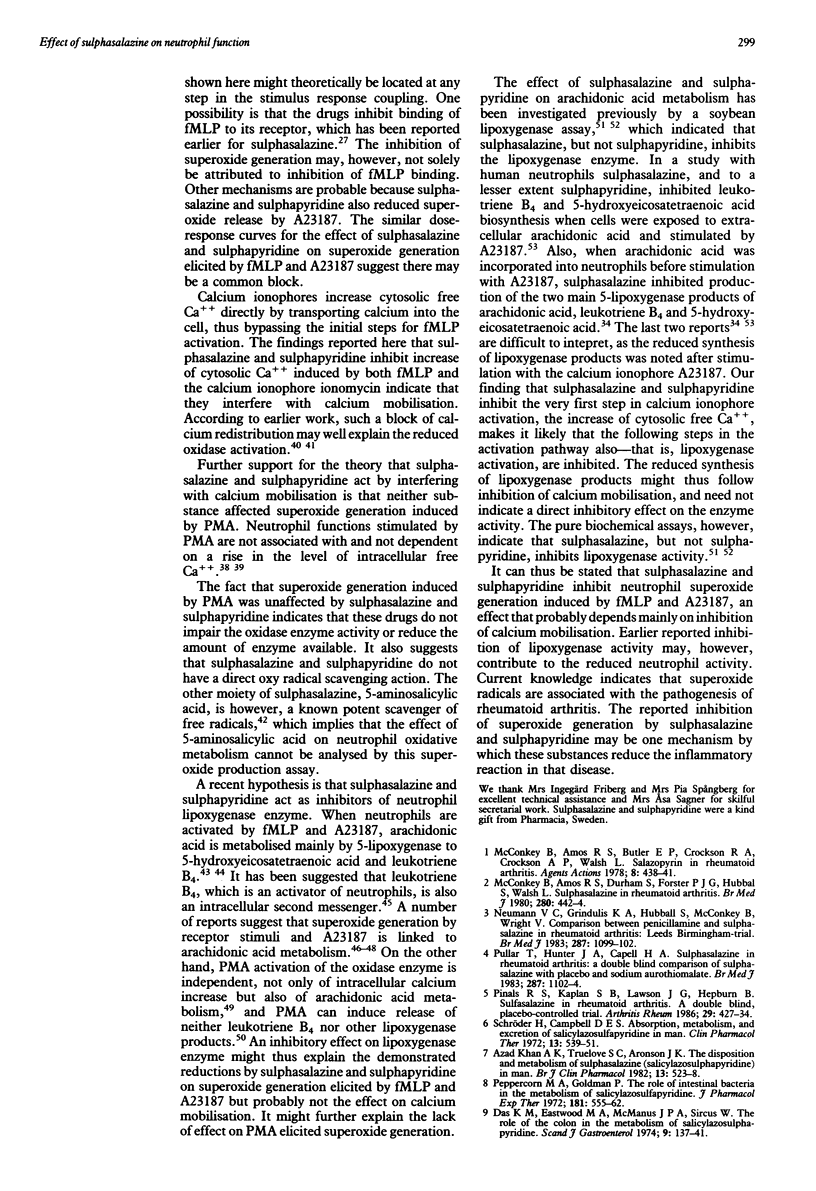Abstract
As the neutrophil granulocyte plays an important part in rheumatoid inflammation the effect of sulphasalazine on neutrophil function was studied. The results show that sulphasalazine, and its metabolite sulphapyridine, inhibit neutrophil superoxide production elicited by the receptor mediated stimulus N-formyl-methionyl-leucyl-phenyl-alanine (fMLP) and by the calcium ionophore A23187. This effect seems to be dependent on inhibition of intracellular Ca++ increase as both substances reduce this increase upon cell activation with fMLP and A23187. Sulphasalazine and sulphapyridine do not inhibit superoxide production after stimulation with the ester phorbol myristate acetate, a stimulus response coupling which is independent of intracellular Ca++ increase. The reported inhibition of superoxide generation may explain, at least partly, the antirheumatic property of sulphasalazine.
Full text
PDF




Selected References
These references are in PubMed. This may not be the complete list of references from this article.
- Ahnfelt-Rønne I., Nielsen O. H. The antiinflammatory moiety of sulfasalazine, 5-aminosalicylic acid, is a radical scavenger. Agents Actions. 1987 Jun;21(1-2):191–194. doi: 10.1007/BF01974941. [DOI] [PubMed] [Google Scholar]
- Allgayer H., Eisenburg J., Paumgartner G. Soybean lipoxygenase inhibition: studies with the sulphasalazine metabolites N-acetylaminosalicylic acid, 5-aminosalicylic acid and sulphapyridine. Eur J Clin Pharmacol. 1984;26(4):449–451. doi: 10.1007/BF00542139. [DOI] [PubMed] [Google Scholar]
- Azad Khan A. K., Piris J., Truelove S. C. An experiment to determine the active therapeutic moiety of sulphasalazine. Lancet. 1977 Oct 29;2(8044):892–895. doi: 10.1016/s0140-6736(77)90831-5. [DOI] [PubMed] [Google Scholar]
- Azadkhan A. K., Truelove S. C., Aronson J. K. The disposition and metabolism of sulphasalazine (salicylazosulphapyridine) in man. Br J Clin Pharmacol. 1982 Apr;13(4):523–528. doi: 10.1111/j.1365-2125.1982.tb01415.x. [DOI] [PMC free article] [PubMed] [Google Scholar]
- Babior B. M. The respiratory burst of phagocytes. J Clin Invest. 1984 Mar;73(3):599–601. doi: 10.1172/JCI111249. [DOI] [PMC free article] [PubMed] [Google Scholar]
- Borgeat P., Samuelsson B. Transformation of arachidonic acid by rabbit polymorphonuclear leukocytes. Formation of a novel dihydroxyeicosatetraenoic acid. J Biol Chem. 1979 Apr 25;254(8):2643–2646. [PubMed] [Google Scholar]
- Comer S. S., Jasin H. E. In vitro immunomodulatory effects of sulfasalazine and its metabolites. J Rheumatol. 1988 Apr;15(4):580–586. [PubMed] [Google Scholar]
- Curnutte J. T. Activation of human neutrophil nicotinamide adenine dinucleotide phosphate, reduced (triphosphopyridine nucleotide, reduced) oxidase by arachidonic acid in a cell-free system. J Clin Invest. 1985 May;75(5):1740–1743. doi: 10.1172/JCI111885. [DOI] [PMC free article] [PubMed] [Google Scholar]
- Di Virgilio F., Lew D. P., Pozzan T. Protein kinase C activation of physiological processes in human neutrophils at vanishingly small cytosolic Ca2+ levels. Nature. 1984 Aug 23;310(5979):691–693. doi: 10.1038/310691a0. [DOI] [PubMed] [Google Scholar]
- Goldstein I. M., Roos D., Kaplan H. B., Weissmann G. Complement and immunoglobulins stimulate superoxide production by human leukocytes independently of phagocytosis. J Clin Invest. 1975 Nov;56(5):1155–1163. doi: 10.1172/JCI108191. [DOI] [PMC free article] [PubMed] [Google Scholar]
- Grynkiewicz G., Poenie M., Tsien R. Y. A new generation of Ca2+ indicators with greatly improved fluorescence properties. J Biol Chem. 1985 Mar 25;260(6):3440–3450. [PubMed] [Google Scholar]
- Halliwell B. Production of superoxide, hydrogen peroxide and hydroxyl radicals by phagocytic cells: a cause of chronic inflammatory disease? Cell Biol Int Rep. 1982 Jun;6(6):529–542. doi: 10.1016/0309-1651(82)90175-8. [DOI] [PubMed] [Google Scholar]
- Hoult J. R., Moore P. K. Effects of sulphasalazine and its metabolites on prostaglandin synthesis, inactivation and actions on smooth muscle. Br J Pharmacol. 1980 Apr;68(4):719–730. doi: 10.1111/j.1476-5381.1980.tb10865.x. [DOI] [PMC free article] [PubMed] [Google Scholar]
- Hurst N. P. Molecular basis of activation and regulation of the phagocyte respiratory burst. Ann Rheum Dis. 1987 Apr;46(4):265–272. doi: 10.1136/ard.46.4.265. [DOI] [PMC free article] [PubMed] [Google Scholar]
- Lehmeyer J. E., Snyderman R., Johnston R. B., Jr Stimulation of neutrophil oxidative metabolism by chemotactic peptides: influence of calcium ion concentration and cytochalasin B and comparison with stimulation by phorbol myristate acetate. Blood. 1979 Jul;54(1):35–45. [PubMed] [Google Scholar]
- Lew P. D., Wollheim C. B., Waldvogel F. A., Pozzan T. Modulation of cytosolic-free calcium transients by changes in intracellular calcium-buffering capacity: correlation with exocytosis and O2-production in human neutrophils. J Cell Biol. 1984 Oct;99(4 Pt 1):1212–1220. doi: 10.1083/jcb.99.4.1212. [DOI] [PMC free article] [PubMed] [Google Scholar]
- Maridonneau-Parini I., Tringale S. M., Tauber A. I. Identification of distinct activation pathways of the human neutrophil NADPH-oxidase. J Immunol. 1986 Nov 1;137(9):2925–2929. [PubMed] [Google Scholar]
- McConkey B., Amos R. S., Butler E. P., Crockson R. A., Crockson A. P., Walsh L. Salazopyrin in rheumatoid arthritis. Agents Actions. 1978 Jun;8(4):438–441. doi: 10.1007/BF01968673. [DOI] [PubMed] [Google Scholar]
- McConkey B., Amos R. S., Durham S., Forster P. J., Hubball S., Walsh L. Sulphasalazine in rheumatoid arthritis. Br Med J. 1980 Feb 16;280(6212):442–444. doi: 10.1136/bmj.280.6212.442. [DOI] [PMC free article] [PubMed] [Google Scholar]
- McCord J. M., Fridovich I. The biology and pathology of oxygen radicals. Ann Intern Med. 1978 Jul;89(1):122–127. doi: 10.7326/0003-4819-89-1-122. [DOI] [PubMed] [Google Scholar]
- McPhail L. C., Clayton C. C., Snyderman R. A potential second messenger role for unsaturated fatty acids: activation of Ca2+-dependent protein kinase. Science. 1984 May 11;224(4649):622–625. doi: 10.1126/science.6231726. [DOI] [PubMed] [Google Scholar]
- Miyachi Y., Yoshioka A., Imamura S., Niwa Y. Effect of sulphasalazine and its metabolites on the generation of reactive oxygen species. Gut. 1987 Feb;28(2):190–195. doi: 10.1136/gut.28.2.190. [DOI] [PMC free article] [PubMed] [Google Scholar]
- Molin L., Stendahl O. The effect of sulfasalazine and its active components on human polymorphonuclear leukocyte function in relation to ulcerative colitis. Acta Med Scand. 1979;206(6):451–457. doi: 10.1111/j.0954-6820.1979.tb13545.x. [DOI] [PubMed] [Google Scholar]
- Neal T. M., Winterbourn C. C., Vissers M. C. Inhibition of neutrophil degranulation and superoxide production by sulfasalazine. Comparison with 5-aminosalicylic acid, sulfapyridine and olsalazine. Biochem Pharmacol. 1987 Sep 1;36(17):2765–2768. doi: 10.1016/0006-2952(87)90262-0. [DOI] [PubMed] [Google Scholar]
- Neumann V. C., Grindulis K. A., Hubball S., McConkey B., Wright V. Comparison between penicillamine and sulphasalazine in rheumatoid arthritis: Leeds-Birmingham trial. Br Med J (Clin Res Ed) 1983 Oct 15;287(6399):1099–1102. doi: 10.1136/bmj.287.6399.1099. [DOI] [PMC free article] [PubMed] [Google Scholar]
- Neumann V. C., Shinebaum R., Cooke E. M., Wright V. Effects of sulphasalazine on faecal flora in patients with rheumatoid arthritis: a comparison with penicillamine. Br J Rheumatol. 1987 Oct;26(5):334–337. doi: 10.1093/rheumatology/26.5.334. [DOI] [PubMed] [Google Scholar]
- Neumann V. C., Taggart A. J., Le Gallez P., Astbury C., Hill J., Bird H. A. A study to determine the active moiety of sulphasalazine in rheumatoid arthritis. J Rheumatol. 1986 Apr;13(2):285–287. [PubMed] [Google Scholar]
- Nielsen O. H., Bukhave K., Elmgreen J., Ahnfelt-Rønne I. Inhibition of 5-lipoxygenase pathway of arachidonic acid metabolism in human neutrophils by sulfasalazine and 5-aminosalicylic acid. Dig Dis Sci. 1987 Jun;32(6):577–582. doi: 10.1007/BF01296156. [DOI] [PubMed] [Google Scholar]
- Palmblad J., Gyllenhammar H., Lindgren J. A., Malmsten C. L. Effects of leukotrienes and f-Met-Leu-Phe on oxidative metabolism of neutrophils and eosinophils. J Immunol. 1984 Jun;132(6):3041–3045. [PubMed] [Google Scholar]
- Peppercorn M. A., Goldman P. Distribution studies of salicylazosulfapyridine and its metabolites. Gastroenterology. 1973 Feb;64(2):240–245. [PubMed] [Google Scholar]
- Peppercorn M. A., Goldman P. The role of intestinal bacteria in the metabolism of salicylazosulfapyridine. J Pharmacol Exp Ther. 1972 Jun;181(3):555–562. [PubMed] [Google Scholar]
- Pullar T., Hunter J. A., Capell H. A. Sulphasalazine in rheumatoid arthritis: a double blind comparison of sulphasalazine with placebo and sodium aurothiomalate. Br Med J (Clin Res Ed) 1983 Oct 15;287(6399):1102–1104. doi: 10.1136/bmj.287.6399.1102. [DOI] [PMC free article] [PubMed] [Google Scholar]
- Pullar T., Hunter J. A., Capell H. A. Which component of sulphasalazine is active in rheumatoid arthritis? Br Med J (Clin Res Ed) 1985 May 25;290(6481):1535–1538. doi: 10.1136/bmj.290.6481.1535. [DOI] [PMC free article] [PubMed] [Google Scholar]
- Safer B., Grunberg-Manago M., Badman D., Bergman F., Freeman C., Galasso G., Jagus R., Williams B. International symposium on translational/transcriptional regulation of gene expression. Highlights of the Fogarty International Center Meeting held in Bethesda, Maryland on 7-9 April, 1982. FEBS Lett. 1982 Oct 4;147(1):1–10. doi: 10.1016/0014-5793(82)81000-4. [DOI] [PubMed] [Google Scholar]
- Sakata A., Ida E., Tominaga M., Onoue K. Arachidonic acid acts as an intracellular activator of NADPH-oxidase in Fc gamma receptor-mediated superoxide generation in macrophages. J Immunol. 1987 Jun 15;138(12):4353–4359. [PubMed] [Google Scholar]
- Schröder H., Campbell D. E. Absorption, metabolism, and excretion of salicylazosulfapyridine in man. Clin Pharmacol Ther. 1972 Jul-Aug;13(4):539–551. doi: 10.1002/cpt1972134539. [DOI] [PubMed] [Google Scholar]
- Seligmann B. E., Fletcher M. P., Gallin J. I. Histamine modulation of human neutrophil oxidative metabolism, locomotion, degranulation, and membrane potential changes. J Immunol. 1983 Apr;130(4):1902–1909. [PubMed] [Google Scholar]
- Sha'afi R. I., White J. R., Molski T. F., Shefcyk J., Volpi M., Naccache P. H., Feinstein M. B. Phorbol 12-myristate 13-acetate activates rabbit neutrophils without an apparent rise in the level of intracellular free calcium. Biochem Biophys Res Commun. 1983 Jul 29;114(2):638–645. doi: 10.1016/0006-291x(83)90828-8. [DOI] [PubMed] [Google Scholar]
- Sheldon P. J., Webb C., Grindulis K. A. Sulphasalazine in rheumatoid arthritis: pointers to a gut-mediated immune effect. Br J Rheumatol. 1987 Aug;26(4):318–319. doi: 10.1093/rheumatology/26.4.318. [DOI] [PubMed] [Google Scholar]
- Smith P. R., Dawson D. J., Swan C. H. Prostaglandin synthetase activity in acute ulcerative colitis: effects of treatment with sulphasalazine, codeine phosphate and prednisolone. Gut. 1979 Sep;20(9):802–805. doi: 10.1136/gut.20.9.802. [DOI] [PMC free article] [PubMed] [Google Scholar]
- Smolen J. E. Lag period for superoxide anion generation and lysosomal enzyme release from human neutrophils: effects of calcium antagonists and anion channel blockers. J Lab Clin Med. 1984 Jul;104(1):1–10. [PubMed] [Google Scholar]
- Stenson W. F., Lobos E. Sulfasalazine inhibits the synthesis of chemotactic lipids by neutrophils. J Clin Invest. 1982 Feb;69(2):494–497. doi: 10.1172/JCI110474. [DOI] [PMC free article] [PubMed] [Google Scholar]
- Stenson W. F., Mehta J., Spilberg I. Sulfasalazine inhibition of binding of N-formyl-methionyl-leucyl-phenylalanine (FMLP) to its receptor on human neutrophils. Biochem Pharmacol. 1984 Feb 1;33(3):407–412. doi: 10.1016/0006-2952(84)90233-8. [DOI] [PubMed] [Google Scholar]
- Stenson W. F., Parker C. W. Metabolism of arachidonic acid in ionophore-stimulated neutrophils. Esterification of a hydroxylated metabolite into phospholipids. J Clin Invest. 1979 Nov;64(5):1457–1465. doi: 10.1172/JCI109604. [DOI] [PMC free article] [PubMed] [Google Scholar]
- Symmons D. P., Salmon M., Farr M., Bacon P. A. Sulfasalazine treatment and lymphocyte function in patients with rheumatoid arthritis. J Rheumatol. 1988 Apr;15(4):575–579. [PubMed] [Google Scholar]
- Walsh C. E., Waite B. M., Thomas M. J., DeChatelet L. R. Release and metabolism of arachidonic acid in human neutrophils. J Biol Chem. 1981 Jul 25;256(14):7228–7234. [PubMed] [Google Scholar]
- Weissmann G., Zurier R. B., Spieler P. J., Goldstein I. M. Mechanisms of lysosomal enzyme release from leukocytes exposed to immune complexes and other particles. J Exp Med. 1971 Sep 1;134(3 Pt 2):149s–165s. [PubMed] [Google Scholar]
- van Hees P. A., Bakker J. H., van Tongeren J. H. Effect of sulphapyridine, 5-aminosalicylic acid, and placebo in patients with idiopathic proctitis: a study to determine the active therapeutic moiety of sulphasalazine. Gut. 1980 Jul;21(7):632–635. doi: 10.1136/gut.21.7.632. [DOI] [PMC free article] [PubMed] [Google Scholar]


